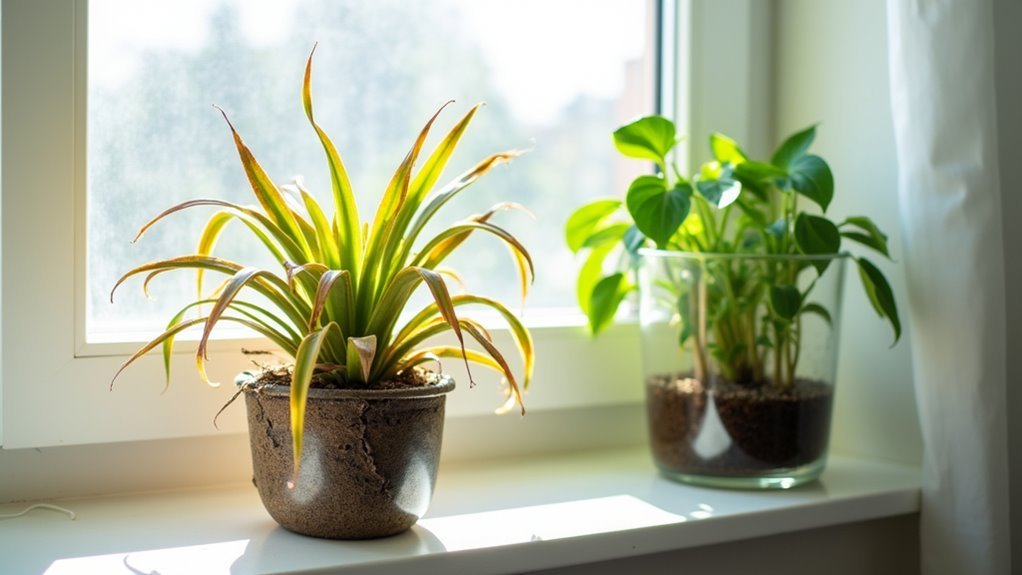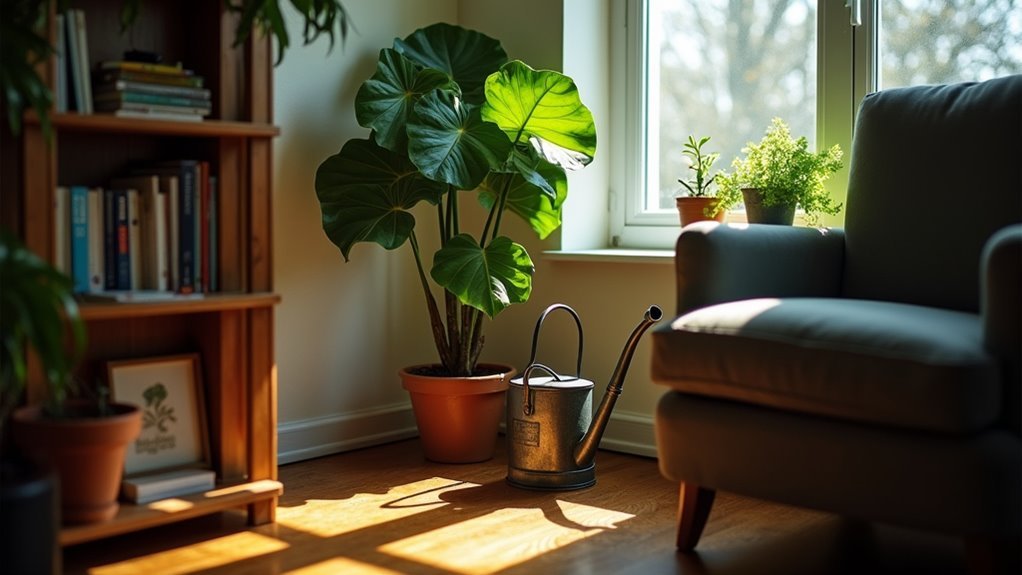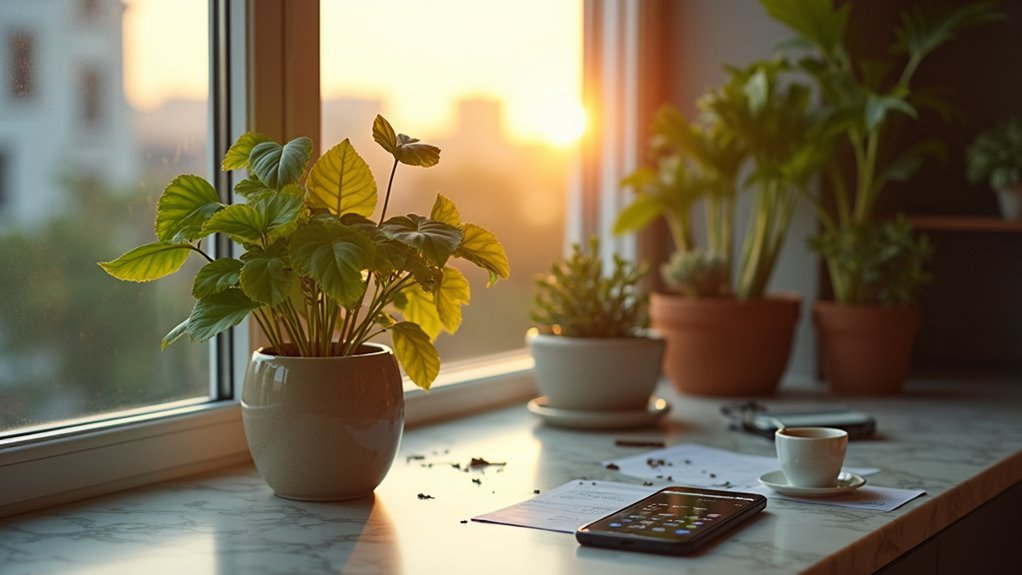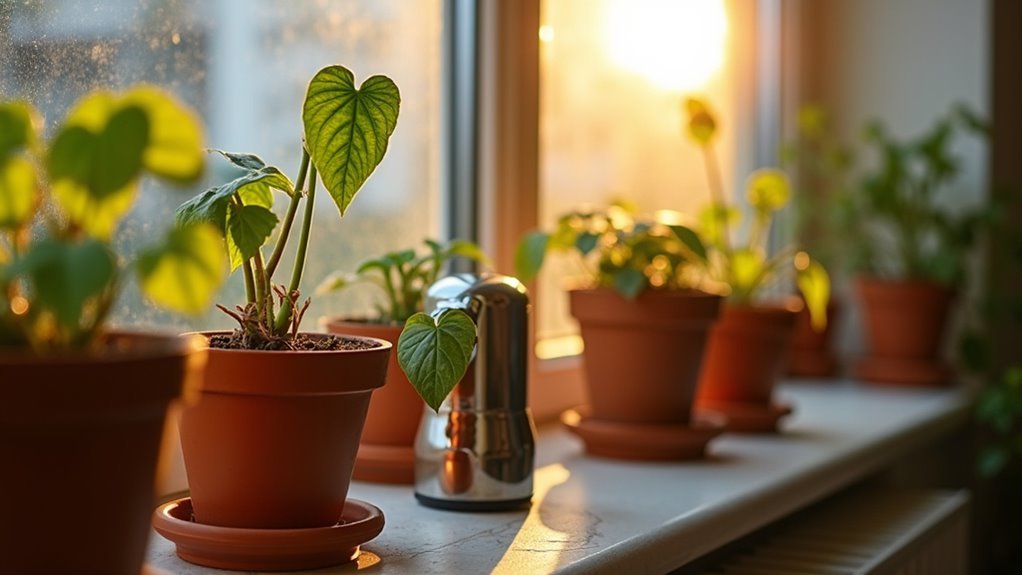You’ve probably watched your apartment plants struggle despite your best efforts, and there’s a fundamental reason why traditional watering methods fall short in urban living spaces. The combination of inconsistent lighting, cramped quarters, and your demanding schedule creates a perfect storm that even the most dedicated plant parent can’t easily navigate. What you might not realize is that self-watering systems address each of these challenges in ways that’ll transform your indoor gardening success.
The Unique Challenges of Growing Plants in Apartments

While apartment living offers many conveniences, it creates distinct obstacles for plant enthusiasts that don’t exist in traditional homes with yards.
You’re dealing with limited natural light, which stresses plants and increases their dependency on proper soil moisture levels. Your busy lifestyle makes consistent watering challenging, leading to either drought-stressed or waterlogged plants.
Small pots dry out faster than garden beds, requiring more frequent attention to watering needs. Temperature fluctuations from heating and cooling systems create unpredictable moisture demands.
Poor air circulation compounds these problems, making plants more vulnerable to inconsistent care.
Self-watering systems address these apartment-specific challenges by maintaining ideal hydration levels automatically, ensuring your plants thrive despite environmental limitations.
Limited Natural Light Affects Plant Water Needs
Among these apartment challenges, limited natural light creates a particularly complex relationship between your plants and their watering needs.
When your apartment receives insufficient sunlight, your plants grow slower and absorb water less frequently. This reduced uptake means you’ll need to adjust your watering schedule considerably.
Plants in limited natural light conditions also transpire less, losing minimal moisture through their leaves. While this sounds beneficial, it actually makes proper watering more challenging since you can’t rely on normal visual cues.
Your ferns and peace lilies become particularly vulnerable during these conditions.
Self-watering systems solve this dilemma by maintaining consistent soil moisture levels. They deliver steady hydration without overwhelming your light-starved plants, creating stable growing conditions despite your apartment’s lighting limitations.
Space Constraints Make Traditional Watering Difficult

You’re constantly maneuvering around furniture and tight corners when watering plants in your cramped apartment, making the simple task feel like an obstacle course.
Your plants often end up in awkward spots like high shelves or narrow windowsills where traditional watering cans can’t reach comfortably.
You’ll struggle to find storage space for watering tools, forcing you to keep them in inconvenient locations that make plant care even more cumbersome.
Limited Floor Space
Space constraints in apartments create significant challenges for maintaining healthy plants through traditional watering methods.
When you’re working with limited floor space, finding room for multiple plants becomes increasingly difficult, especially when you need clear pathways for watering access. Traditional watering requires you to maneuver around furniture and navigate tight spaces with watering cans or hoses, often leading to awkward positioning and potential spills.
Self-watering pots eliminate these spatial challenges by reducing your need for frequent manual watering sessions.
You can strategically place plants in corners, on shelves, or in previously inaccessible areas without worrying about regular watering access. A self-watering system maximizes your apartment’s plant potential while minimizing the physical space required for maintenance activities.
Awkward Plant Placement
Anyone who’s lived in a cramped apartment knows the frustration of having gorgeous spots for plants that become watering nightmares. That perfect corner shelf or windowsill becomes a hassle when you’re constantly climbing chairs or squeezing into tight spaces for plant watering.
You’ll find yourself avoiding those awkward spots, and your plants suffer from inconsistent care.
Self-watering systems solve this exact problem by eliminating the need to physically reach every plant regularly. Your greenery can stay hydrated automatically, even in the most inconvenient locations.
You won’t have to choose between aesthetic placement and practical care anymore. These systems let you confidently position plants wherever they’ll thrive visually, knowing they’ll maintain proper moisture levels without your constant intervention in cramped quarters.
Watering Tool Storage
Beyond placement challenges, storing watering equipment in cramped apartments creates another layer of frustration.
You’re constantly juggling watering cans, spray bottles, and measuring cups in already-packed cabinets or closets. These bulky watering tools eat up precious storage space that you desperately need for other essentials.
Self-watering planters eliminate this storage nightmare entirely. You won’t need multiple containers cluttering your limited space anymore.
These systems reduce the number of tools required for plant care, freeing up storage for things that actually matter to your daily life.
Modern self-watering planters come in sleek designs that complement your apartment’s aesthetic while functioning independently.
You’ll maintain healthy plants without overwhelming your storage areas with traditional watering equipment that creates chaos in compact living environments.
Busy Urban Lifestyles and Plant Care Schedules

Your unpredictable work schedule doesn’t align with your plants’ need for consistent watering, leaving them either parched or drowning depending on when you remember to care for them.
Business trips that stretch for days or weeks create additional stress as you worry about returning to wilted greenery in your apartment.
Even weekend getaways become complicated when you’re constantly thinking about whether your plants will survive until Monday.
Irregular Work Schedules
When your work schedule shifts unpredictably from early morning meetings to late-night deadlines, maintaining a consistent plant watering routine becomes nearly impossible.
You’ll find yourself either forgetting to water for days or overcompensating with too much moisture when you finally remember.
Self-watering systems eliminate this guesswork by maintaining a consistent level of hydration regardless of your chaotic schedule.
These innovative solutions feature water reservoirs that supply your plants automatically through capillary action.
Benefits of automated watering for irregular schedules:
- No more plant casualties during unexpected overtime or business trips
- Consistent moisture delivery prevents stress-induced yellowing and wilting
- Deeper root development occurs when plants access water naturally
- Reduced weekend plant maintenance frees up your precious downtime
- Peace of mind knowing your green companions thrive independently
Frequent Business Travel
Business trips that stretch from three days to three weeks create an even greater challenge for apartment plant care than unpredictable daily schedules.
When you’re constantly traveling for work, you can’t rely on inconsistent watering habits or emergency plant-sitting arrangements. Self-watering systems eliminate this stress by maintaining consistent moisture levels while you’re away.
These systems feature a water reservoir that slowly releases water as your plants need it, preventing both drought stress and root rot from overwatering.
Frequent travelers particularly benefit from this automated approach, as studies show plants in self-watering pots grow healthier and larger than those dependent on human schedules.
You’ll return from business trips to thriving plants rather than wilted reminders of neglect.
Weekend Getaway Challenges
While business travel demands weeks of absence, spontaneous weekend getaways present their own unique plant care dilemma for busy urban dwellers.
Your unpredictable urban lifestyle makes consistent plant care challenging, especially when last-minute opportunities arise.
Weekend trips create specific risks for your apartment plants:
- Most houseplants can survive 10 days without care, but high-maintenance varieties need constant moisture
- Asking neighbors or friends to water plants increases overwatering or underwatering risks
- Spontaneous plans don’t allow time to arrange proper plant care
- Inconsistent watering schedules stress plants and cause damage
- Daily attention requirements conflict with your busy lifestyle
Self-watering systems eliminate these concerns by maintaining consistent moisture levels automatically.
You’ll enjoy worry-free weekends knowing your plants receive proper hydration without depending on others or compromising their health.
How Self-Watering Systems Solve Apartment Plant Problems
Although apartment living brings unique challenges for plant enthusiasts, self-watering systems effectively address the most common issues you’ll face as an indoor gardener.
These innovative solutions use capillary action to draw water from reservoirs, ensuring your plants receive consistent hydration without daily monitoring. You’ll eliminate the guesswork of watering schedules while preventing both overwatering and underwatering disasters.
Self-watering systems eliminate daily watering guesswork while preventing both overwatering and underwatering through reliable capillary action technology.
Since apartments often lack adequate natural light and ventilation, soil dries faster than in outdoor environments.
Self-watering systems retain moisture longer, creating stable growing conditions despite these limitations. You can finally enjoy houseplants without constant worry, even during busy weeks or weekend trips.
Plus, you’re conserving water and reducing waste—perfect for eco-conscious urban living where every drop counts.
Understanding Capillary Action and Wicking Methods
You’ll need to understand how capillary action powers these self-watering systems to make the best choices for your apartment plants.
This natural process uses molecular attraction to pull water upward through narrow spaces, just like how a paper towel absorbs spilled liquid.
Rope wicking systems harness this principle by using absorbent materials like cotton strings to transport water from a reservoir directly to your plant’s soil.
How Capillary Action Works
When you set up a self-watering system, you’re harnessing capillary action—a natural process that moves water through narrow spaces without requiring pumps or electricity.
This mechanism relies on two key forces working together to deliver moisture directly to your apartment plants.
Here’s how capillary action functions in your self-watering setup:
- Adhesive forces attract water molecules to soil particle surfaces
- Cohesive forces bind water molecules together, creating continuous flow
- Wicking material like cotton rope transfers water from reservoir to soil
- Soil composition determines how effectively water moves through spaces
- Consistent moisture levels prevent overwatering while promoting healthy root growth
Your plants can then absorb water as needed, maintaining ideal hydration without constant monitoring or manual watering schedules.
Rope Wicking Systems
Rope wicking systems represent the most accessible and cost-effective approach to self-watering for apartment dwellers. You’ll position an absorbent wick with one end submerged in your water reservoir and the other buried in soil. Capillary action draws water upward through molecular attraction, guaranteeing your plants receive consistent moisture without overwatering risks.
| Component | Function | Maintenance |
|---|---|---|
| Wick Material | Transfers water via capillary action | Keep continuously moist |
| Water Reservoir | Stores water supply | Refill as needed |
| Soil Contact | Delivers moisture to roots | Prevent compaction |
This autonomous system reduces manual watering frequency while maintaining ideal soil moisture. You’ll need to verify the wick stays moist and prevent soil compaction for successful operation. The molecular attraction between water and surfaces enables upward movement against gravity.
Choosing the Right Self-Watering System for Small Spaces
Five key factors determine whether a self-watering system will thrive in your apartment’s limited space.
You’ll need to evaluate each element carefully to maximize both functionality and aesthetics in your compact living environment.
- Size and placement: Choose compact designs that fit seamlessly on windowsills or shelves while ensuring ideal light exposure for your plants.
- Water capacity: Select self-watering pots with adequate water reservoir capacity to sustain plants for 2-4 weeks between refills.
- Wicking efficiency: Look for systems featuring absorbent materials that transfer water effectively without causing over-saturation.
- Visual appeal: Opt for containers that complement your apartment’s decor while maintaining essential plant health functions.
- Monitoring features: Consider pots with clear water level indicators for easy reservoir monitoring without environmental disruption.
DIY Self-Watering Solutions for Apartment Dwellers
Budget-conscious apartment dwellers can create effective self-watering systems using common household items and basic crafting skills.
You’ll need two containers for the most basic DIY self-watering setup—use the larger one as your water reservoir and place your plant in the smaller container. Thread a cotton rope through the drainage hole to act as a wick, drawing moisture upward into the soil.
For terracotta pots, simply submerge the bottom third in a water bowl. The porous material will gradually water the plant through natural seepage.
Terracotta’s natural porosity creates an automatic watering system when the pot sits partially submerged in water.
Repurpose plastic bottles by poking holes in caps and inverting them in soil for slow-drip irrigation. These solutions work perfectly for both indoor and outdoor container gardens, keeping your plants hydrated without frequent attention.
Converting Standard Pots to Self-Watering Systems
Instead of starting from scratch, you can transform your existing pots into self-watering systems with minimal effort and cost.
This DIY conversion method creates a water reservoir beneath your plant container using simple materials you likely already have at home.
Materials and setup you’ll need:
- Larger container – serves as your water reservoir base
- Existing smaller pot – holds your plant and soil
- Cotton rope or absorbent material – acts as the wick system
- Drill or sharp tool – creates hole for wick threading
- Monthly maintenance schedule – check and refill reservoir regularly
Thread the wick through a hole in your pot’s bottom, ensuring one end stays submerged in the water reservoir while the other extends into the soil.
Your plants will absorb moisture as needed.
Best Plant Types for Self-Watering in Apartments
While self-watering systems work wonderfully for many houseplants, choosing the right varieties will determine your success with this automated watering method.
Success with self-watering systems depends entirely on selecting the right plant varieties for this automated approach.
You’ll find excellent results with low to moderate maintenance plants like Pothos, Philodendron, and Monstera, which thrive with consistent moisture. Alocasia and Hoya are also perfect candidates, enjoying consistently moist soil without root rot risks.
Herbs like basil and parsley flourish in self-watering systems since they need regular watering for ideal growth. These systems act like a reliable plant sitter, ensuring your plants receive proper hydration.
However, avoid succulents and cacti entirely. These plants prefer drying out completely between waterings, making self-watering systems problematic. When you water your plants this way, you’ll risk overwatering these desert varieties.
Maintaining Proper Moisture Levels Without Overwatering
You’ll find that wicking systems excel at delivering just the right amount of water your plants need through capillary action.
This controlled moisture delivery prevents the soil from becoming waterlogged, which is the primary cause of root rot in apartment plants.
Wicking System Benefits
Because the wicking system relies on capillary action to pull water from a reservoir into the soil, your plants receive steady moisture without the constant threat of overwatering.
This self-watering technology transforms how you care for apartment plants by letting them drink exactly what they need.
The wicking system delivers several key advantages:
- Prevents root rot by eliminating water-logged soil conditions
- Reduces watering frequency for busy schedules and travel periods
- Promotes healthier root development through consistent moisture levels
- Conserves water with gradual, controlled release
- Minimizes fungal diseases by preventing over-saturation
You’ll find this system particularly valuable if you’re frequently away or tend to forget watering schedules.
Your plants can thrive independently while you focus on other priorities, making apartment gardening more manageable and successful.
Preventing Root Rot
Root rot stands as one of the most destructive threats to apartment plants, but self-watering systems offer a reliable defense against this common problem. Self-watering pots maintain consistent moisture levels by allowing plants to absorb water as needed through capillary action. This prevents the soggy soil conditions that typically cause root rot and diseases.
| Traditional Watering | Self-Watering Systems | Result |
|---|---|---|
| Inconsistent moisture | Steady water supply | Healthier roots |
| Risk of overwatering | Controlled water access | Reduced root rot |
| Manual monitoring | Automatic regulation | Less plant stress |
You’ll find these systems particularly beneficial if you’re busy or travel frequently. The reservoir guarantees your plants won’t suffer from neglect or overwatering. By checking and refilling the reservoir regularly, you’ll maintain ideal conditions that promote healthy root growth while minimizing waterlogging risks.
Travel-Friendly Plant Care for Apartment Residents
When travel plans arise, apartment dwellers often worry about leaving their green companions unattended for days or weeks.
Self-watering systems eliminate this concern by delivering the water they need through reliable capillary action, drawing moisture from a built-in reservoir directly to plant roots.
These innovative planters offer several travel advantages:
- Consistent hydration – Plants receive steady moisture without daily intervention
- Extended coverage – Systems typically sustain plants for 1-2 weeks depending on size
- Low-maintenance indicators – Built-in gauges show reservoir levels before departure
- Climate stability – Counteracts fluctuating apartment temperatures from heating/cooling systems
- Overwatering prevention – Eliminates guesswork that leads to root damage
You’ll return from trips knowing your plants thrived independently, making apartment gardening stress-free regardless of your travel schedule.
Cost-Effective Automation for Indoor Plant Success
Three key factors make self-watering systems a smart financial investment for apartment gardeners: reduced plant mortality, lower water waste, and eliminated care service costs.
You’ll save money immediately by preventing plant deaths from inconsistent watering schedules. When plants die from neglect or overwatering, you’re buying replacements repeatedly—an expensive cycle that self-watering systems break.
These automated solutions use capillary action to deliver precise water amounts, eliminating waste from overwatering or runoff.
You’re conserving both water and money on utility bills while maintaining healthier plants.
The upfront investment pays dividends through long-term savings. You won’t need expensive plant-sitting services during travel, and your indoor gardening hobby becomes sustainable.
Multiple plants become manageable without hiring help or risking plant loss.
Long-Term Benefits of Self-Watering for Urban Gardens
Beyond immediate savings, self-watering systems transform your urban gardening experience into a sustainable, long-term practice that adapts perfectly to city living demands.
These systems create lasting value by maintaining consistent moisture levels that promote deeper root development, making your plants more resilient to urban environmental fluctuations.
You’ll conserve precious water resources through efficient regulation while reducing your maintenance workload considerably.
The long-term advantages include:
- Enhanced plant health through steady hydration and reduced watering stress
- Water conservation via precise moisture control in resource-limited urban settings
- Increased gardening participation encouraging more residents to embrace green living
- Improved air quality as more people successfully maintain thriving indoor plants
- Sustainable urban gardening practices that support eco-friendly city lifestyles
Your investment pays dividends through healthier plants and simplified care routines.
Frequently Asked Questions
What Is the Purpose of Self-Watering Plants?
Self-watering plants automatically maintain ideal moisture levels through capillary action. You’ll enjoy consistent hydration for your plants without overwatering risks, reduced maintenance time, healthier root development, and water conservation benefits.
Why Is Automatic Plant Watering System Important?
You’ll maintain consistent moisture levels while preventing overwatering and underwatering. These systems save time, support plant health during travel, promote stronger root growth, and reduce water waste through efficient delivery.
Are Self-Watering Plants Worth It?
You’ll find self-watering plants absolutely worth it since they’ll prevent over and underwatering while saving you time. They’ll help your plants grow healthier and larger with minimal maintenance required.
What Are the Disadvantages of Self-Watering Plants?
You’ll face overwatering risks that cause root rot, potential mosquito breeding in reservoirs, wicking system failures, increased maintenance demands, and compatibility issues since some plants don’t thrive with constant moisture access.





Leave a Reply